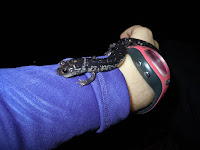Last year (this got away from me, maybe I can catch up and be on time this year...?), spring sampling started out slow because it was very dry, but became insane when the rain started up. Salamanders respond quickly to rain, especially after a dry spell. For any new readers and as a reminder to anyone who doesn't study amphibians for a living...amphibians have permeable skin meaning they cannot regulate water loss through evaporation very well. The salamanders I study in Southern Appalachia, and two thirds of all salamanders, additionally don't have lungs. This means they have to maintain wet skin to breath through their skin. This is why they are not active during very dry periods and will rapidly become active with rain to take advantage of any time available.
Let's start with a game. Can you spot the salamander? ;)
On the other hand, red salamanders (Pseudotriton ruber) look like a toy dropped in the woods by mistake...We found this girl last spring once the rain started!
We also found this similar but slightly less vibrant salamander, the Spring salamander (Gyrinophilus prophyriticus). You can see eggs through the skin on her side!
My favorite thing about spring sampling is all of the wildflowers. They pop up early to take advantage of the sunlight before the trees leaf out. Trilliums, showy orchids and pink lady slippers are some of the most ostentatious!
One night we were walking between sites and almost stepped on this well camouflaged ruffed grouse. We are not sure if she was nesting or just sleeping but she did not fly away while we took a few pictures.
A year round treat in the mountains are stunning rainbows created by the patchy rainfall (allowing the sun to peak through). Rainbows are created by sunlight passing through water droplets. The water acts like a prism and splits the light into separate colors. Can you spot the double in the pictures below?
Spring is also breeding season for some salamander species. Under thick moss near streams or seeps we found one of the smallest salamanders in the area (usually about 3-4 cm total length) protecting her eggs. This seepage salamander (Desmognathus aenus), like most plethodontids, will stay with her eggs until they hatch. This not only can help protect the eggs from predators, it also protects them from drying out and from disease. In such moist environments, fungi are everywhere. The adult salamander have anti-fungal bacteria on their skin that protects the eggs from such invasions.
Male Plethodontid salamanders develop an enlarged mental gland (swollen patch on the chin pictured below. Those in the genus Plethodon are especially large! The mental gland is used to deliver pheromones to females for breeding.
Last year we saw salamanders of all sizes, from very tiny to the largest I've ever seen!
I had never seen Pipevine flowers before, so that was really fun!
 |
| Pipevine flowers |
Below are a bunch of fun pictures from past summer. One consequence of waiting to write this up is I don't remember if there are stories associated with them.
 |
| Climbing Pygmy Salamander |
 |
| Ringneck snake |
 |
| Another Red Salamander (Pseudotriton ruber) |
 |
| Really nice red legs on this (Plethodon shermani) |
 |
| Pretty long tail on this two-lined salamander |
One of the most interesting things we found this summer were these bright pink or white patches of something that looked like crystals on leaves. They turned out to be velvet galls created by mites. Looking at them under a handheld microscope was amazing! We think the white ones had lost pigment, but were pink (based on some of the pictures below with partial color).
We found a Red bellied snake (Storeria occipitomacualta) along the road one night.


The next week I found a Dekay's brown snake (Storeria dekai) at my house in Athens, which I had not seen before but knew what genus it was based on similarities to the red bellied snake we saw in NC!
Summer- It continued to be dry but we saw a few things!
Red salamander with lots of spots! Looks like she has been eating chocolate cake with sprinkles!
 |
| Red eft stage of the Eastern Red spotted newt |
 |
| Garter snake in a small tree |
 |
| Luna Moth!! |
 |
| Faint rainbow with clouds rolling in over the mountains |
 |
| Cool fungus! |
 |
| Cute climber! |
 |
| Rough earth snake! |
 |
Plethodon when we were weighing it,
but gave us this face... |
 |
| Pretty Ocoee! |
 |
| Huge rat snake! |
 |
| Super pretty Ocoee! |
My students and I did a little herping in Athens and saw lots of frogs calling (Cricket Frog, Grey Treefrog, and Barking Treefrog)
 |
| Cute anole eating a bug! |
Pictures from my student's summer projects:
Fall-Fall was also dry with relatively few salamanders, but several spring salamanders (Gyrinophilus porphyriticus)!!
Couple of Earth Snakes!!
Saw these salamanders in the tail-straddle-walk, which is part of the courtship behaviors!
 |
| Spermatophore laid down by the male in the picture above |
Maybe this year I can stay on top of things!! :)











































































































